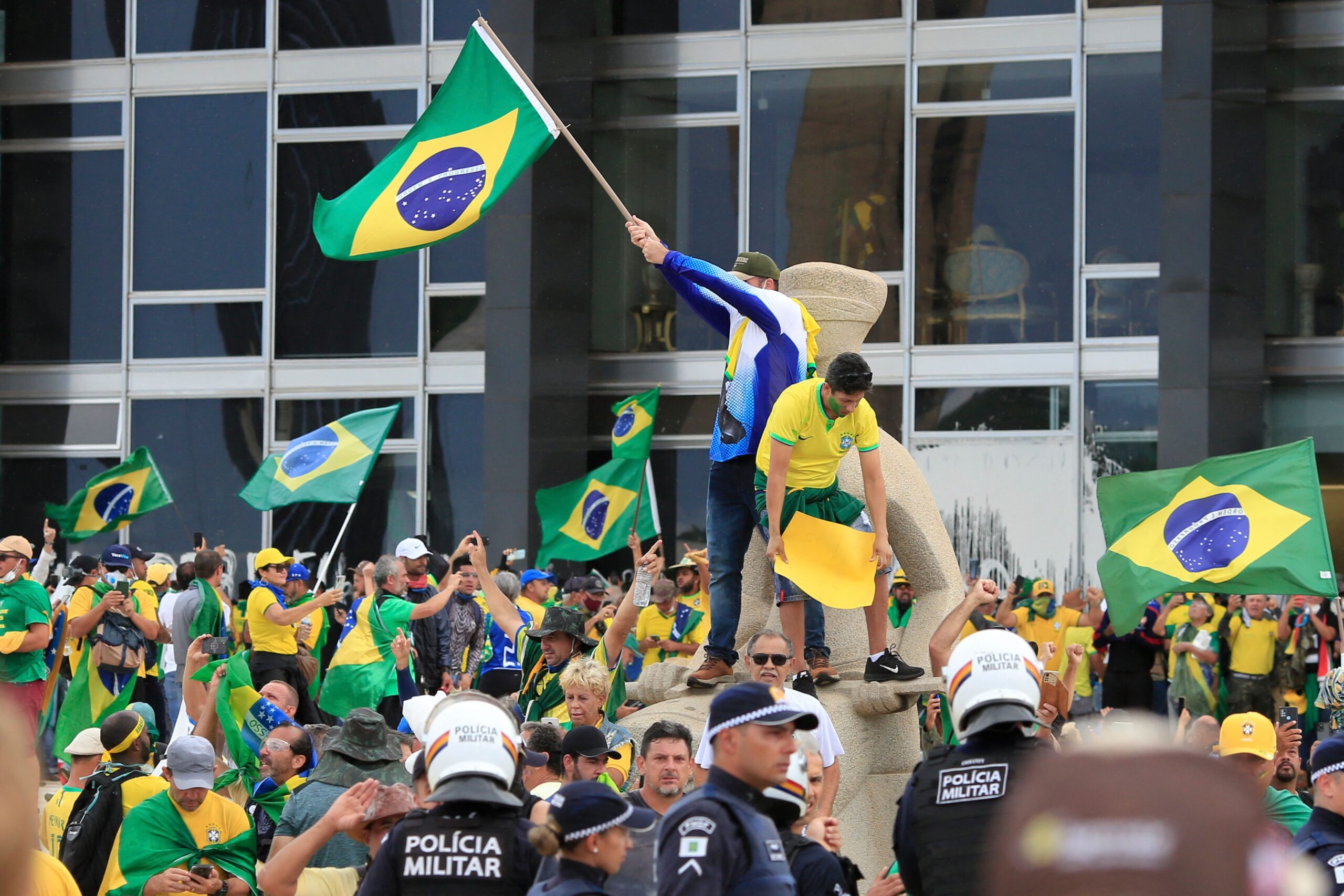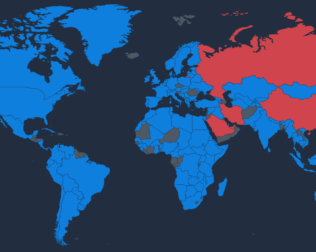By Roberta Braga
Broken glass, destroyed offices, and vandalized artwork littered Brazilian government buildings after January 8th. How did Brazil get here? In part, this story is not just about polarization, but about how disinformation spread into the roots of the Brazilian polity.
In Brazil, government and civil society have worked to combat the continued spread of false and misleading information, and have found that debunking false claims is insufficient. To successfully combat disinformation, they must also address radical groupthink, counter the tactics disinformers use to frame alternate realities online, and close existing gaps in social media regulation. In doing so, Brazilian authorities and civic groups can apply existing frameworks to counter specific disinformation tactics and craft stronger, multidisciplinary strategies that prioritize reconciliation, fact-finding, and legislative—rather than judicial—action.
A Framework for Understanding Disinformation Tactics
Understanding the tactics used by bad actors to spread disinformation is imperative for combatting its harms. The four Ds of disinformation, a well-established tactical blueprint coined by Ben Nimmo, can help frame how those who spread (and consume) disinformation in Brazil shape discourse to advance their preferred narratives.
Dismiss: When encountering narratives with which they disagree, disinformers will often dismiss such claims by attacking or discrediting mainstream media outlets and the political opposition. Since 2018, attacks undermining the Brazilian media, initially spearheaded by Bolsonaro himself, have become commonplace. Attacks against the left are also frequent. In monitoring WhatsApp groups and conversations online, Equis (the author’s organization) came across various instances in which, when confronted with fact-checks about accusations of election fraud, various Brazilian far-right supporters dismissed the evidence, claiming it was corrupted by the left. Those on Brazil’s far-right either assert that they have done their own research and found proof of fraud, or contend that specific messengers, including the judiciary, were politically biased or bought-off by President Lula and his supporters.
Distort: Disinformers are experts at distorting information to benefit their preferred narrative. Following the insurrection on January 8, hardline Bolsonaro supporters began circulating digitally manipulated videos supposedly evincing the false claim that the left and the Workers’ Party had infiltrated the “protests” and were the principal actors leading the violence and destruction. Efforts to create distance between themselves and the insurrection took root immediately, and these false narratives are now deeply ingrained in many right-wing circles.
Distract: Disinformers often attempt to “change the subject” from arguments that counteract their version of reality or “counter-accuse” others of the same wrongdoings. Hyper-partisan disinformation-spreaders in Brazil have used distraction both in the lead up to and following January 8—any accusation they faced was immediately redirected at the opposition and governing Workers’ Party. For example, many on Brazil’s far-right accused Lula of corruption and claimed he avoided conviction arbitrarily, referencing oft-cited historical precedents of corruption that past Brazilian governments similarly faced.
Dismay: Dismay refers to scare-tactics employed by disinformers to intimidate opponents. Rage among Brazil’s more radicalized factions often has been most prominent when under duress. In response to accusations of responsibility for the January 8 insurrection, extreme right-wing Brazilians have threatened civil war and called for widespread armament—calls that rose to new levels during the Bolsonaro presidency. There have also been death threats directed toward President Lula, the President of the Superior Electoral Court, Alexandre de Moraes, and other top officials in the government, as well as attacks against journalists and the mainstream media.
Implications for Brazilian Decision-makers and Civil Society
Brazil’s government and civil society must work together to address systemic issues underpinning polarization and a crisis of trust post-January 8.
1. Establish a commission to investigate the insurrection, assuring its focus remains on fact-finding and lays out a path for reconciliation.
This commission, which must include representatives from all political parties, should be tasked with establishing the facts, investigating the sequence of events, determining who financed the insurrection, identifying who facilitated it, and instituting accountability with checks and balances. Such a commission should also outline steps for reconciliation that address the lack of public trust in democratic institutions. Here, referencing democratic reconciliation and accountability processes from Germany to Rwanda to the United States could offer interesting insights.
In establishing the facts and identifying a path toward reconciliation, the commission should consult experts who have tackled these issues in the recent past and those in civil society. This process cannot be a witch hunt—nearly 50 percent of Brazilians voted for Bolsonaro. Painting one side as the enemy will do nothing to address the factors that led to the radicalization of the most hardline wing of his supporters. Instead, this process must be a free and fair arbitration of facts, taking the nuances of this issue into account. Civil society can help assure lawmakers understand the information-related issues and the broader discontent, while permitting diverse voices to be represented.
2. Brazilian decision-makers need to harness and adopt a multidisciplinary approach to addressing this challenge, employing best practices from a variety of specializations.
We must prioritize understanding how other disciplines, including movement-builders, extremism experts, and hostage negotiators, among others, have tackled radicalization, instead of forwarding analyses focused solely on disinformation.
A multidisciplinary approach can help experts understand the growth trajectory of radicalization in Brazil (and elsewhere in the world). The creators of disinformation are people, so the human component of this set of challenges cannot be set too far to the side. The narrative-building piece is just as important as the fact-finding and the execution of penalties for crimes committed.
We have underestimated the extent to which alternate realities are becoming ingrained in the mindset of a large part of the Brazilian population through communities that exist separate from the mainstream. Other disciplines’ best practices could help address existing knowledge gaps.
3. Brazil’s congress, working with civil society experts on freedom of expression, data privacy, and information integrity, should advance legislation that focuses on enhancing social media platform transparency and effective content moderation, rather than solely criminalizing content.
In the years preceding Jair Bolsonaro’s election to the presidency, less than half of Brazilians cited the Internet as a means of staying informed, and only 26 percent cited it as a main source for information. Today, Brazilians are among the highest users of social media for news: Almost 64 percent of Brazilians report getting their news from social media networks, and Brazil’s social media landscape is more crowded than ever. YouTube has overtaken Facebook as Brazil’s most popular online platform for news. Information consumption on Instagram (35 percent), TikTok (12 percent), WhatsApp (41 percent), and Telegram (9 percent) is also increasing according to recent research conducted by the Reuters Institute and Oxford University.
The hyper-digital nature of media consumption in Brazil, combined with the country’s huge population and low trust in media and government institutions (54 percent of Brazilians reported that they avoid traditional news outlets) has opened the door for the massive spread of false and misleading information with significant consequences. For example, a recent survey shows 85 percent of Brazilians report being “very or extremely concerned” about “what is real and what is fake on the Internet when it comes to news.”
Social media platforms are vectors of disinformation. Their scale and scope—and the features that enable people to self-select their preferred echo chambers and online communities for news—sowed some of the seeds for the January 8 insurrection.
Platforms must be held legally responsible to oversee the security of their “public square” properly and effectively. Legislation that focuses primarily on disinformation itself is not the answer—such laws are often too broad in their definition of the term, and this lack of clarity can lead to censorship if turned on journalists, as has happened in other countries worldwide.
Legislation must instead focus on the systemic issues that enable false information to circulate widely, including ineffective content moderation practices, problematic algorithmics, a lack of transparency by companies, and data mishandling.
It must also ensure platforms be held responsible for adequately applying terms of service and moderation equitably across languages and borders, as well as focus on reducing issues with tools that facilitate wide circulation of harmful content despite platform encryption. Just one month following the insurrection, for example, WhatsApp launched “Communities” in Brazil, which now allow one user to speak to and share information with up to 5,000 users at once. This feature allows disinformation to go viral more easily as it is shared among and between large groups. It is likely to exacerbate—not slow—the speed at which disinformation spreads on the widely used messaging platform.
If left unaddressed, this problem will persist. Laws need to be modernized to reflect the information environment in which we live.
Looking Ahead: The Perils of a Unilateral Response
Brazil has stepped up to tackle the causes and effects of its January 8 insurrection quickly and increasingly decisively. What comes next could determine the survival of its democracy. Disinformation is a borderless, cyclical phenomenon that requires multi-stakeholder solutions that address underlying systemic challenges. Amassing power under one entity or mandating unilateral takedowns of social media accounts, as the Brazilian judiciary has recently done, will not fix the ingrained suspicion and rage ingrained in some far-right circles in Brazil. The focus should instead go to crafting a multidisciplinary strategy that addresses the disinformation tactics used in Brazil, the false realities that are becoming internalized into the psyche of everyday Brazilians, and the gaps in platform accountability at the legislative level.
Ultimately, Brazilians will have to grapple with deep-seated questions that have been debated for years and, now, face a decision point.
Roberta Braga is the Director of Counter-Disinformation Strategies at Equis and a NED Penn Kemble fellow (2021-2022). Follow her on Twitter @robertasbraga.
The views expressed in this post represent the opinions and analysis of the author and do not necessarily reflect those of the National Endowment for Democracy or its staff. Image Credit: Getty Images/SERGIO LIMA/Contributor.






